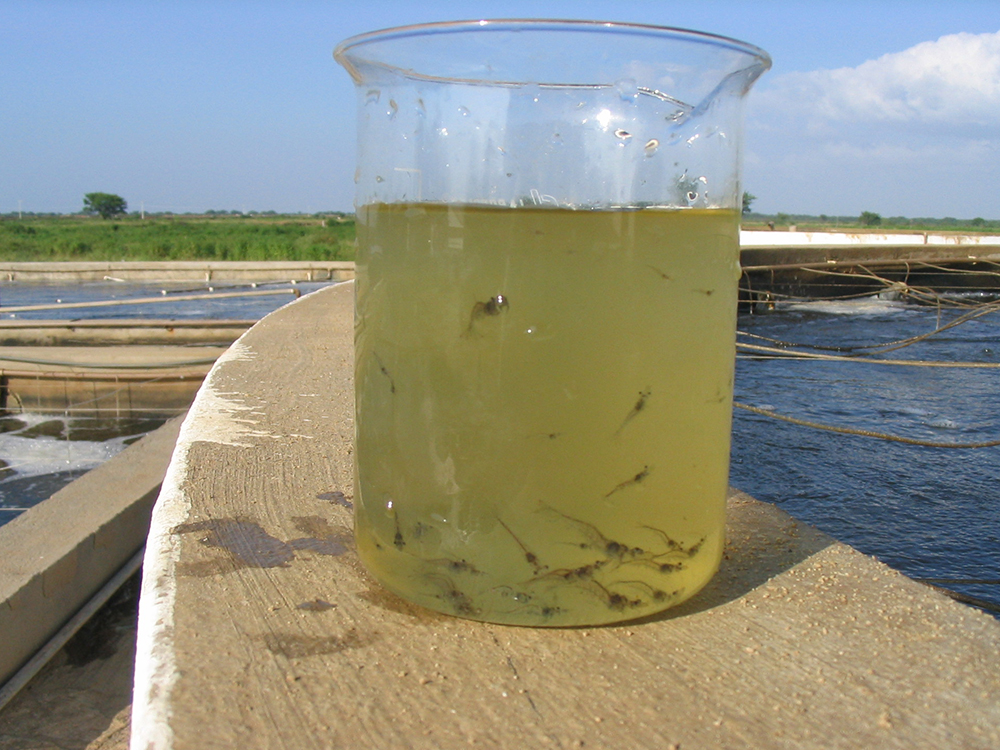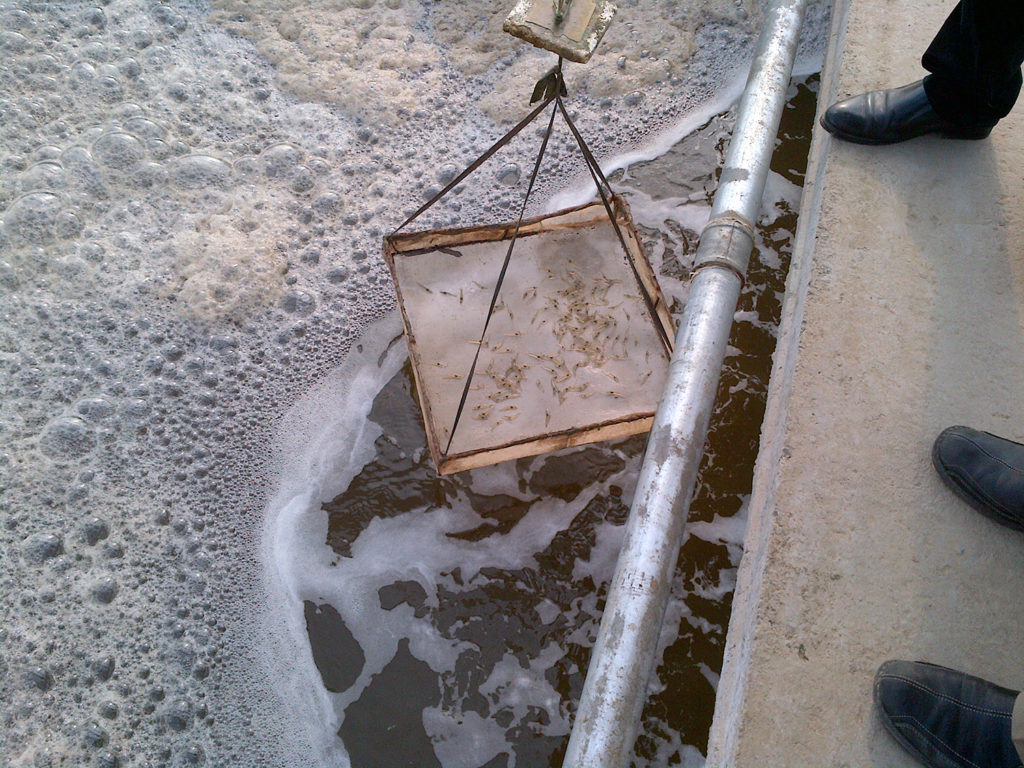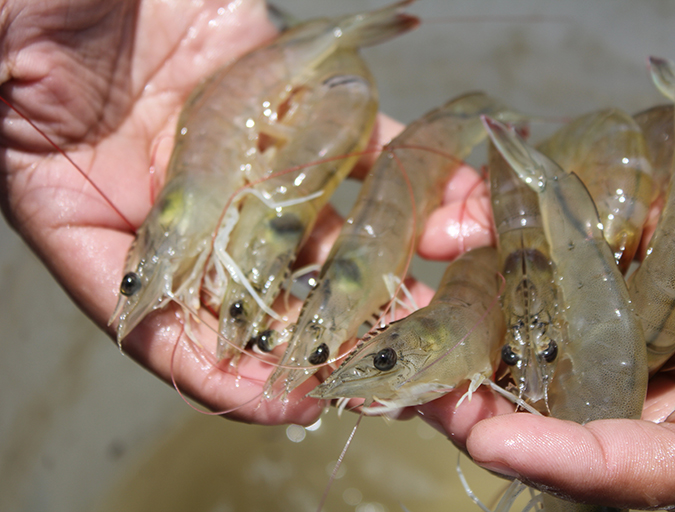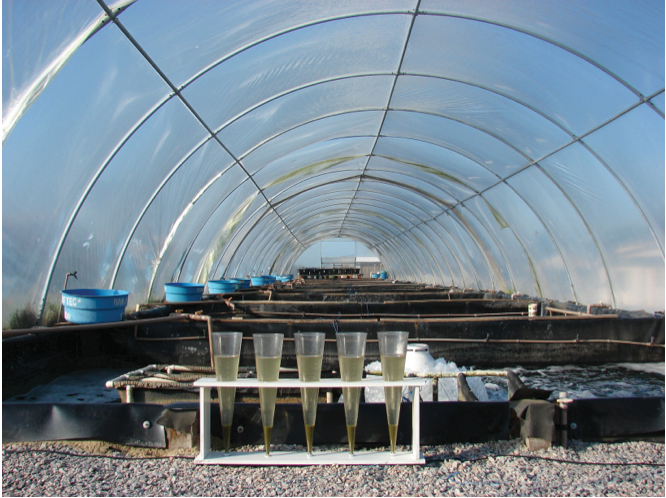Implementation a quick, relatively inexpensive way to lower risk and increase efficiency, profits

Hyper-intensive nursery systems for juvenile shrimp production have been around for decades. In the last several years, it has been recognized that they represent one of the most significant opportunities for the shrimp-farming industry to increase profits. System design and management have also improved to facilitate a consistent, low-risk “factory model” defined by foreseeable production inputs and stable, predictable operating results.
Nursery systems
Hyper-intensive shrimp nurseries typically feature a bio-secure production system built in or close to a shrimp grow-out facility. They incorporate environmental controls to grow postlarvae at high densities from 2 to 300 mg weight or greater. Nursery culture results in strong, healthy and uniform juveniles with great potential for compensatory growth when stocked in production ponds. Sample construction costs and proportional operational costs are shown in Tables 1 and 2.
Gervais, Construction costs for a shrimp nursery, Table 1
| Units | Facility/Equipment | Cost (U.S. $) |
|---|---|---|
| 1 | Plastic cover | 8,500 |
| 1 | Pipe and equipment | 13,500 |
| 1 | Greenhouse structure, drainage system | 50,000 |
| 2 | 30-kw diesel generators | 20,000 |
| 20 | 10-m-diameter round tanks with 1-mm HPDE liners | 45,000 |
| 3 | 10-hp regenerative blowers | 11,000 |
| 2 | 5-hp diesel water pumps | 2,000 |
| Total | 150,000 |
Gervais, Proportions of operational costs, Table 2
| Proportion of Costs (%) | |
|---|---|
| Feed | 46 |
| Additives and buffers | 12 |
| Probiotics | 7 |
| Salaries | 13 |
| Energy | 12 |
| Miscellaneous | 10 |
The main objectives of nursery systems include faster average growth in production ponds after transfer and preventing disease by exclusion and using controlled temperatures – above 32 degrees-C to address the white spot syndrome virus, for example. Nurseries also produce a maximum number of juveniles of a desired weight and improve the health and resistance of animals to be stocked into ponds.
The benefits of these systems include stocking farms earlier to meet health regulations, gains during seasonal cold temperatures and the option to buy postlarvae (P.L.) in periods of low demand and lower prices. Nursery systems offer the opportunity for compensatory gain, which allows earlier harvests and entering the market sooner to get better prices. Correct use can reduce production costs by reducing the time in large ponds and increase pond efficiency through additional cycles per year.
Siting, building considerations
At many farms, it is impossible to construct this type of system in an ideal location to meet all criteria, but it is recommended that the water should be sourced from the intake channel or before the pump station to allow draining and dry-out of the main reservoir channel without affecting its operation. The water should drain into the farm discharge channel away from the intake.
To lower costs, it is advisable to locate the nursery close to existing main and emergency backup power sources. If possible, it should be located near the farm’s main administration area – close to offices, supplies and personnel. Ideally, the facility should be constructed high enough for good drainage and no more than 10 minutes travel time away from the farthest pond.
Single-phase nursery tanks
Single-phase nursery tanks are typically designed to stock 2- to 10-mg postlarvae to produce 100-, 200- or 300-mg juveniles. The tanks are normally from 40 to 200 cubic meters in volume and are built under greenhouse or shade cloth coverings.
Single-phase nursery tank systems are generally built in four different shapes. Typically, they are round with a center drain or oval with a center wall for good circulation to keep solids in suspension. Rectangular tanks typically have a water inlet opposite water discharge, while stacked shallow rectangular systems are used for super-high densities and space efficiency.
Most of these systems are built of concrete, wire mesh, wood, plastic, fiberglass or formed soil with a liner or epoxy covering. Stocking densities range 8-50/P.L./L to produce juveniles of 0.1-to 0.3-gram harvest size. Final biomass harvests yield 1-5 kg/cubic meter.
Round tanks are inexpensive and easy to build, with good circulation for feed distribution and sludge removal. This cuts down on investment, personnel needs and human error. Their disadvantages are that they are not space efficient and need large, unique cover designs and support structures to house them.
Oval tanks have great circulation for keeping solids in suspension and waste removal, and fit well under greenhouse roofing. Although they can be somewhat more difficult to build and manage than other designs, the highest biomasses have been achieved with these systems.
The advantages of rectangular tanks include ease of construction, space efficiency under standard greenhouses and familiarity of use by hatchery technicians. However, sludge removal and feed distribution can be less efficient, and the tanks are expensive to build, operate and manage. More personnel are needed to operate them, and they offer a limited final biomass.
Stacked shallow raceways can maximize biomass in a minimum footprint – up to 10 times more mass than that of other systems. Raceways are unmatched in efficiency to control temperature, feeding and personnel inputs. They are ideal for extreme environments where space and temperature are limitations.
The stacked systems are relatively new and considered unproven or complicated to some, with few examples of how to buy, build and operate them available. This type of system will likely become much more common in supporting hyper-intensive growout operations and inland shrimp farming in cold environments.
Second-phase nursery tanks
Second-phase nursery tanks are similar to single-phase systems, but operate on a larger scale.
The reason for a second-phase nursery at farm level is related to stocking a greater number of larger juvenile shrimp into production ponds than would be possible from a single-phase system. This strategy is usually beneficial where crops are seasonal and where the first farms that harvest get higher prices. Second-phase tanks can also support additional crop cycles.
These systems are typically built with rounded central drain, oval or rectangular tanks or ponds with sizes ranging from 300 to 7,500 cubic meters. For stocking, 0.1- to 0.3-g juveniles are transferred from a first-phase system. Densities range 0.5-5.0/P.L./L to produce juveniles with harvest weights of 1 to 3 grams. Final biomass volumes at harvest run 1-3 kg/cubic meter.
Water treatment, monitoring
The water for nurseries should be as clean as possible and come from the same source used for production ponds. Water can be pumped into reservoirs or directly to production tanks.
To aid in biosecurity, most systems use prefiltration and disinfection of incoming water, such as initial sand filtration, 5- to 50-µ cartridge filtration and 20-ppm chlorination.
Designs demanding the highest levels of biosecurity use additional filtration and/or treatments with ozone or ultraviolet light and final cartridge filtration.
Mandatory support equipment includes properly sized incoming water pump and distribution pipes and blowers with sufficient capacity and minimum emergency backup power. Round tanks usually use 0.5-1.0 hp/100 cubic meter tank space. Rectangular tanks usually use 2-3 hp/100 cubic meter tank space. Newer designs using venturis or air injectors both aerate and circulate the water without the need for blowers at all. These have lower initial capital investments and lower operating costs while increasing the carrying capacity of the system.
Because of the considerable biomasses found in intensive nurseries, continual monitoring of various parameters is essential. Essential equipment includes gear to measure levels of dissolved oxygen, ammonia, nitrogen dioxide, alkalinity, free chlorine and hydrogen sulfide in water, as well as temperature, pH, shrimp weight and feed use.
Intensive nurseries versus direct stocking
Hyper-intensive shrimp nurseries seek to fulfill the same goals as the small, low-density pond nursery systems used by producers for decades, but in a controlled environment with high biosecurity. Intensive nurseries allow much more efficient use of ponds’ carrying capacity than direct stocking of postlarvae provides, while at the same time reducing risk. Because of shorter pond cycles, daily fixed costs are also reduced for each kilogram of shrimp produced. An economic comparison of direct stocking versus transfer of juvenile shrimp from a nursery is shown in Table 3.
Gervais, Economic calculations comparing profits, Table 3
| Input Data | Direct Stocking | Juvenile Transfer | Difference | Difference |
|---|---|---|---|---|
| Pond size (ha) | 1.0 | 1.0 | – | 0% |
| Density (postlarvae/m2) | 12 | 12 | – | 0% |
| Growth rate (g/week) | 0.80 | 1.00 | 0.20 | 25.0% |
| Harvest weight (g) | 15.00 | 15.00 | – | 0% |
| Survival (%) | 65% | 70% | 0.05 | 7.7% |
| Feed-conversion ratio | 1.5 | 1.3 | (0.20) | -13.3% |
| Postlarvae cost (U.S. $/1,000) | $3.00 | $5.50 | $2.50 | 83.3% |
| Sale price (U.S. $/lb) | $5.00 | $5.00 | – | 0% |
| Feed cost (U.S. $/lb) | $0.50 | $0.50 | – | 0% |
| Other costs (U.S. $/day) | $22.00 | $22.00 | – | 0% |
| Calculations | Difference | Difference | ||
| Cycle length (days) | 131.25 | 105.00 | (26.25) | -20.0% |
| Postlarvae stocked | 120,000 | 120,000 | – | 0% |
| Harvest weight (lb) | 2,577.09 | 2,775.33 | 198.24 | 0.2% |
| Market value (U.S. $) | $12,885.46 | $13,876.65 | $991.19 | 7.7% |
| Postlarvae cost (U.S. $) | $360.00 | $660.00 | $300.00 | 83.3% |
| Feed given (lb) | 3,865.64 | 3,607.93 | (257.71) | -6.7% |
| Feed cost (U.S. $) | $1,932.82 | $1,803.96 | ($128.85) | -6.7% |
| Other costs (U.S. $) | $2,887.50 | $2,310.00 | $577.50 | 25.0% |
| Cost/lb Sold | Difference | Difference | ||
| Postlarvae cost (U.S. $) | $0.14 | $0.24 | $0.098 | 70.2% |
| Feed cost (U.S. $) | $0.75 | $0.65 | $(0.100) | -13.3% |
| Other costs (U.S. $) | $1.12 | $0.83 | $(0.288) | -25.7% |
| Profit | Difference | Difference | ||
| Income over costs (U.S. $) | $7,705.14 | $9,102.69 | $1,397.54 | 18.1% |
| Additional growth opportunity (U.S. $) | $991.19 | |||
| Transfer Profit Advantage | $2,388.73 |
Juveniles of 0.1-0.3 g, U.S. $2-3/1,000
Juveniles of 1.0-3.0 g, U.S. $4-5/1,000
Table 3. Economic calculations comparing profits expected for systems using directly stocked postlarvae or juveniles transferred from a single-phase nursery system.
Proven benefits
The greatest economic gains from the use of nurseries exist when there is opportunity to stock postlarvae at a farm when temperatures are too low for open pond stocking and to have a large quantity of juveniles ready to stock when temperatures increase or regulations permit. Producers can also reduce time to harvest by having juveniles ready to restock a pond following a harvest, increasing cycles per year or size of shrimp at harvest. Additional important benefits can be seen when stocking ponds with low primary water productivity and when juveniles of sufficient size are needed to go directly onto pelleted feeds.
Compensatory growth
Gains from compensatory growth can be realized when postlarval shrimp are in a situation of controlled slow growth for a period of time, such as in nurseries. When growth conditions change favorably, shrimp have the ability to regain lost weight very quickly and achieve a normal age-based weight – as seen after transfer into grow-out ponds.
To obtain maximum compensatory gains, juveniles need to be fed sufficient high-quality feed specifically designed to provide all the nutrients necessary to obtain this rapid growth. The accelerated growth is easily lost if shrimp receive feed of poor nutritional quality or in insufficient quantities.
As an example of compensatory growth, after direct stocking into a grow-out pond, postlarvae can achieve a size of 1 to 2 grams, depending on temperature. A juvenile of 0.1 to 0.3 g produced in a nursery for three weeks can reach a size of 4 to 6 grams about four weeks after transfer to ponds.
Bottom Line: Implementation of hyper-intensive nursery systems is a quick, relatively inexpensive way to lower risk and increase efficiency and profits at shrimp farms.
(Editor’s Note: This article was originally published in the January/February 2014 print edition of the Global Aquaculture Advocate.)
Authors
-
Neil Gervais
Technical Sales Manager – Shrimp Feeds
Zeigler Bros., Inc.
P. O. Box 95
Gardners, Pennsylvania 17324 USA[109,111,99,46,100,101,101,102,114,101,108,103,105,101,122,64,115,105,97,118,114,101,103,46,108,105,101,110]
-

Thomas R. Zeigler, Ph.D.
Senior Technical Advisor
Past President and Chairman
Zeigler Bros., Inc.
P. O. Box 95
Gardners, Pennsylvania 17324 USA
Related Posts

Health & Welfare
Building a better shrimp nursery, part 1
Shrimp nursery systems offer an important opportunity to increase profits. Properly designed and operated nurseries are highly biosecure facilities to grow postlarvae at very high densities.

Health & Welfare
Building a better shrimp nursery, part 3
Shrimp nursery systems offer significant potential for compensatory growth after juveniles are transferred to ponds for final grow-out. Nursery feed selection and their management are critical components of shrimp nursery systems.

Aquafeeds
Testing shrimp growth in different biofloc systems
A study conducted with juvenile shrimp (Litopenaeus vannamei) reared in experimental biofloc systems used four treatments. Results indicate that differences in management and carbohydrate source can lead to substantial disparity in system function and production.

Health & Welfare
Ammonia addition enhances microbial flocs in nursery phase for Pacific white shrimp
In a study, “pre-fertilization” in the nursery phase of a biofloc system for shrimp was tested. The objective was to accelerate the biofloc formation to minimize ammonia concentrations, avoiding high peaks during culture.


